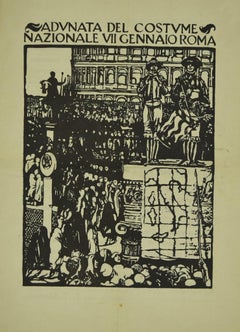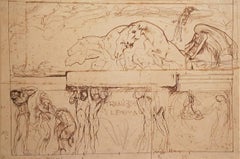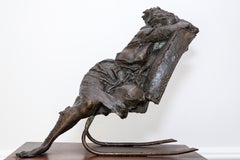Giulio Aristide Sartorio Art
Italian, 1860-1932
Giulio Aristide Sartorio was an Italian painter and film director from Rome. Alongside the activity of landscape artists who saw him, in 1904, he was also among the promoters of the XXV group of the Roman Campagna. He also had numerous public commissions like the famous decorative frieze for the new parliament hall (1908–12), which merges literary inspiration with refined design elegance.
to
4
3
3
1
Overall Height
to
Overall Width
to
3
3
2
1
1
1
1
1
1
1
1
4
1
1
1
4
6,996
3,346
2,513
1,213
1
1
1
1
1
Artist: Giulio Aristide Sartorio
Sibilla - Original Rare book Illustrated by Giulio Aristide Sartorio - 1922
By Giulio Aristide Sartorio
Located in Roma, IT
Sibilla is an original couple of books engraved by Giulio Aristide Sartorio (Rome, 1860 - 1932) in 1922.
Original First Edition.
1333 numbered and signed copies.
Published by L'Eroica, Milan.
Format: in 4°. The dimensions of the book are indicative.
The book includes 230 pages with 219 etchings (70 of them are in full page).
Good conditions.
Giulio Aristide Sartorio (11 February 1860 – 3 October 1932) was an Italian painter and film director from Rome. Having attended the Rome Institute of Fine Arts, Sartorio presented a Symbolist work at the 1883 International Exposition of Rome. He formed friendships with Nino Costa and Gabriele D’Annunzio, and associated with the painters and photographers of the Roman countryside. He won a gold medal at the Paris Universal Exhibition of 1889 and met the Pre-Raphaelites in England in 1893. His participation in the Venice Biennale began in 1895 with the 1st International Exposition of Art of Venice, after which he taught at the Weimar Academy of Fine Arts from 1896 to 1898. His period of greatest renown came at the beginning of the century, when he produced decorative friezes for the 5th Esposizione Internazionale d’Arte of Venice (1903), the Mostra Nazionale of Fine Arts (Milan, Parco Sempione...
Category
1920s Symbolist Giulio Aristide Sartorio Art
Materials
Paper
Gathering of the Costume - Woodcut by G.A. Sartorio -1938
By Giulio Aristide Sartorio
Located in Roma, IT
Gathering of the Costume is a woodcut print realized by Giulio Aristide Sartorio in 1938.
The album composed of 10 pages, was realized for the Royal wedding of King Umberto of Savoy...
Category
1930s Modern Giulio Aristide Sartorio Art
Materials
Woodcut
Sketch for the Parliament Hall “Thanatos and the Enigma” - 1900s - Drawing
By Giulio Aristide Sartorio
Located in Roma, IT
Original drawing, pencil on paper. A wonderful sketch for the frieze for Parliament Hall in Montecitorio Palace, in Rome.
Good conditions except for a diffused foxing, including a w...
Category
Early 1900s Modern Giulio Aristide Sartorio Art
Materials
Ink
Satiro - Original Bronze Sculpture by Giulio Aristide Sartorio
By Giulio Aristide Sartorio
Located in Roma, IT
Bronze head sculpture realized by Giulio Aristide Sartorio, an Italian painter, sculptor and film director from Rome.
Having attended the Rome Institute of Fine Arts, Sartorio presented a Symbolist work at the 1883 International Exposition of Rome. He made friendships with Nino Costa and Gabriele D’Annunzio, and associated with the painters and photographers of the Roman countryside.
His period of greatest renown came at the beginning of the century, when he produced decorative friezes for the 5th Esposizione Internazionale d’Arte of Venice (1903), the Mostra Nazionale of Fine Arts (Milan, Parco Sempione...
Category
Early 20th Century Modern Giulio Aristide Sartorio Art
Materials
Bronze
Related Items
Figure of a Woman Sleeping in a Rocking Chair by Bruno Lucchesi
By Bruno Lucchesi
Located in Brookville, NY
This bronze sculpture of a woman in a chair, is typical of the work of Bruno Lucchese. Born in Italy in 1926, Bruno Lucchesi has been referred to as “the last of the Renaissance scu...
Category
1960s American Modern Giulio Aristide Sartorio Art
Materials
Bronze
H 18 in W 9 in D 16 in
After Alberto Giacometti, Man Standing Up, Bronze Figure
By Alberto Giacometti
Located in Pasadena, CA
Modern bronze with gold patina figural sculpture, in the style of Alberto Giacometti (Swiss, 1901-1966), not signed, depicting abstract nude male a figures, in a parcel gilt finish, ...
Category
1950s Modern Giulio Aristide Sartorio Art
Materials
Bronze
1961 Coty Award Plaque Kenneth Hairdresser Jacqueline Onassis Bronze Fashion
Located in New York, NY
1961 Coty Award Plaque Kenneth Hairdresser Jacqueline Onassis Bronze Fashion
Bronze on wood. The wood plaque measures 12 3/4" by 20 3/4 inches. The bronze plaque itself is 13 3/4 x 8 3/4 inches and the the bronze inscription, which reads "COTY, American Fashion Critics Special Award 1961 to KENNETH of LILY DACHE...
Category
1960s American Modern Giulio Aristide Sartorio Art
Materials
Bronze
Mid-Century Derrière le Miroir Lithograph by Alexander Calder
By Alexander Calder
Located in Soquel, CA
Mid-Century Derrière le Miroir Lithograph by Alexander Calder
Vintage 1960's Alexander Calder double-page Lithograph, unsigned, part of portfolio "Derriere le Miroir". Published by:...
Category
1960s Modern Giulio Aristide Sartorio Art
Materials
Paper, Ink
H 24 in W 30 in D 0.33 in
Mexican Art Abstract Brutalist Biomorphic Bronze Sculpture Mathias Goeritz
By Mathias Goeritz
Located in Surfside, FL
Mathias Goeritz (German Mexican, 1915-1990)
Bronze sculpture
Signed and numbered
Dimensions: (approximate) Height: 10 inches, Width: 4 inches, Depth: 2 inches.
This is a cast bronze sculpture in an amorphous figure shape, quite heavy. Reminiscent of the biomorphic sculpture of Hans Jean Arp. This came from an estate and bears his signature It is not dated. there is no accompanying documentation. it is priced accordingly.
Werner Mathias Goeritz Brunner (Danzig, Germany, April 4th, 1915/ now Gdansk, Poland – Mexico City, Mexico; August 4th, 1990).
Mathias Goeritz has had several gallery and museum exhibitions, including at the Museo Nacional Centro de Arte Reina Sofía and at the Museo Experimental El Eco. Numerous works by the artist have been sold at auction, including 'MENSAJE' sold at Sotheby's New York 'Latin American Modern Art' in 2015 for $466,000. There have been Several articles about Mathias Goeritz, including 'LACMA remaps Latin America' written by Suzanne Muchnic for the Los Angeles Times.
Painter, sculptor and Mexican architect associated with the trend of constructive abstraction. He studied medicine at the University of Berlin, but this only lasted a year. The concerns of the young student were aesthetic in nature so he he studied figurative drawing at the Berlin Charlottenburg School of Art. Some of his friends and colleagues were the sculptor Ernst Barlach, painter George Grosz and draughtsman Kaethe Kollwitz. Goeritz studied philosophy and history of art, discipline in which earned a doctorate. He travelled in France, Switzerland, Czechoslovakia, Poland, Austria and Italy, among other countries.
It is known that he left Germany to live in Tetuan, Morocco in 1941 and then Granada, Spain in 1945. In 1946 he had a large exhibition in the Sala Clan in Madrid under the pseudonym "Mago". Two years later, living in Santilla del Mar, Spain he was a founder of the Escuela de Altamira. The following year he married Marianne Gast, writer and his companion for more than fifteen years. In Spain followed his artistic work by important artists of the avant-garde.
Of Jewish descent, he found refuge from the Second World War in Mexico where in 1949 he was invited by Ignacio Diaz Morales to be a part of the faculty of the School of Architecture at the Universidad de Jalisco. In 1953 he wrote the "Manifiesto de la Arquitectura Emocional" (The Emotional Architecture Manifesto), where he points out that only achieving true emotions from architecture can it then be considered an art form. In Mexico he entered controversy with the artistic stablishment of that country; in an open letter, Diego Rivera and David Alfaro Siqueiros described him as "an impostor without the most insignificant talent and preparation" to be an artist. Despite this, in 1957 he was elected director of visual design of the National School of architecture This same year he founded the Museo del Eco in Mexico City. In 1961 Goeritz participated at the Galería Antonio Souza in a group exhibition, Los hartos, for which he published another manifesto. Other participants included Jose Luis Cuevas and Pedro Friedeberg, with whom he was instrumental in establishing abstraction and other modern trends in Mexico.His work is included in the Gelman Collection of modern and contemporary Mexican art based in Cuernavaca, Mexico. Established by Jacques and Natasha Gelman in 1943 as a private collection. it includes many iconic works by major Mexican Modernists including Frida Kahlo, Diego Rivera, David Alfaro Siqueiros, Leonora Carrington, Rufino Tamayo and Francisco Toledo, Lola Alvarez...
Category
20th Century Modern Giulio Aristide Sartorio Art
Materials
Bronze
'Madman's Drum (Plate 41)' — 1930s Graphic Modernism
By Lynd Ward
Located in Myrtle Beach, SC
Lynd Ward, 'Madman's Drum, Plate 41', wood engraving, 1930, edition small. Signed in pencil. A fine, black impression, on off-white tissue-thin Japan paper; the full sheet with margins (1 5/8 to 2 1/2 inches); a small paper blemish in the upper right margin, away from the image, otherwise in excellent condition. Scarce. Matted to museum standards, unframed.
Image size 5 1/2 x 3 3/4 inches (140 x 95 mm); sheet size 9 5/8 x 7 1/8 inches (244 x 181 mm).
From Lynd Ward’s book of illustrations without words, 'Madman’s Drum', Jonathan Cape and Harrison Smith, New York, 1930. Illustrated in 'Storyteller Without Words: The Wood Engravings of Lynd Ward', Harry Abrams, New York, 1974.
Reproduced in 'Storyteller Without Words, the Wood Engravings of Lynd Ward', Harry N. Abrams, New York, 1974.
ABOUT THE ARTIST
Lynd Ward is acknowledged as one of America’s foremost wood engravers and book illustrators of the first half of the twentieth century. His innovative use of narrative printmaking as a stand-alone storytelling vehicle was uniquely successful in reaching a broad audience. The powerful psychological intensity of his work, celebrated for its dynamic design, technical precision, and compelling dramatic content, finds resonance in the literature of Poe, Melville, and Hawthorne. Like these classic American writers, Ward was concerned with the themes of man’s inner struggles and the role of the subconscious in determining his destiny. An artist of social conscience during the Great Depression and World War II, he infused his graphic images with his unique brand of social realism, deftly portraying the problems that challenged the ideals of American society.
The son of a Methodist preacher, Lynd Ward, moved from Chicago to Massachusetts at an early age. He graduated from the Teachers College of Columbia University, New York, in 1926, where he studied illustration and graphic arts. He married May Yonge McNeer in 1936 and left for Europe for their honeymoon in Eastern Europe. After four months, they settled in Leipzig, where Ward studied at the National Academy of Graphic Arts and Bookmaking. Inspired by Belgian expressionist artist Frans Masereel's graphic novel ‘The Sun,’ and another graphic novel by the German artist Otto Nückel, ‘Destiny,’ he determined to create his own "wordless" novel. Upon his return to America, Ward completed his first book, ‘God's Man: A Novel in Woodcuts,’ published in 1929. ‘Gods’ Man’ was a great success for its author and publisher and was reprinted four times in 1930, including a British edition. This book and several which followed it, ‘Madman’s Drum,’ 1930, ‘Wild Pilgrimage...
Category
1930s American Modern Giulio Aristide Sartorio Art
Materials
Woodcut
At New York (Self Portrait)
By Shiko Munakata
Located in Fairlawn, OH
At New York (Self Portrait)
Woodcut, 1961
Unsigned (as issued)
From: The "Way" of the Woodcut, three woodcuts, 1961
Publisher: Pratt Adlib Press, Brooklyn, New York,1961
Printer: Jam...
Category
1960s Modern Giulio Aristide Sartorio Art
Materials
Woodcut
'Young Girl, Black Cat', LACMA, Psychedelic Japanese Wood-Block, Tokyo Biennale
Located in Santa Cruz, CA
Signed, lower left, 'T. Nakayama' for Tadashi Nakayama (Japanese, 1927-2014), dated 1973 and inscribed, lower right, with number and edition limitation, '21/75'.
Paper dimensions: 3...
Category
1970s Modern Giulio Aristide Sartorio Art
Materials
Gold Leaf, Silver
H 31 in W 21.5 in D 0.13 in
Topol in Fiddler on the Roof (Hand signed by Chaim Topol and the original cast)
Located in New York, NY
Chaim Topol in Fiddler on the Roof (Hand signed by Chaim Topol and the original cast members), 1990
Offset lithograph poster (ink signed)
Hand signed in ink by Chaim Topol, Marcia Le...
Category
1990s Modern Giulio Aristide Sartorio Art
Materials
Offset, Lithograph, Ink
H 22 in W 14.5 in D 0.5 in
No Footprints Show, Where the Flowers Grow Deep
By Shiko Munakata
Located in Fairlawn, OH
No Footprints Show, Where the Flowers Grow Deep
Woodcut, 1961
Unsigned (as isssued)
From: The "Way" of the Woodcut, three woodcuts, 1961
Publisher: Pratt Adlib Press, Brooklyn, New Y...
Category
1960s Modern Giulio Aristide Sartorio Art
Materials
Woodcut
Laudation of the Art
Located in Middletown, NY
Color etching printed in gradient red, orange, yellow, green, blue, and violet ink, 8 3/8 x 15 inches (212 x 380 380 x mm), full margins. Signed, titled and numbered 46/100 in pencil, lower margin.
Arnold Gross...
Category
Mid-20th Century American Modern Giulio Aristide Sartorio Art
Materials
Color, Etching, Ink
Alexander Calder Mid Century Derrière le Miroir Lithograph
By Alexander Calder
Located in Soquel, CA
Vintage 1960s Alexander Calder Lithograph double page part of portfolio "Derriere le Miroir". Published by: Galerie Maeght, Paris, 1966. No. 156. Text on verso. Unsigned from an unknown edition. Presented in black mat with red core. Mat size: 20"H x 24"W. Image size: 15"H x 22"W.
American artist Alexander Calder changed the course of modern art by developing an innovative method of sculpting, bending, and twisting wire to create three-dimensional “drawings in space.” Resonating with the Futurists and Constructivists, as well as the language of early nonobjective painting, Calder’s mobiles (a term coined by Marcel Duchamp in 1931 to describe his work) consist of abstract shapes made of industrial materials––often poetic and gracefully formed and at times boldly colored––that hang in an uncanny, perfect balance. His complex assemblage Cirque Calder (1926–31), which allowed for the artist’s manipulation of its various characters presented before an audience, predated Performance Art by some 40 years. Later in his career, Calder devoted himself to making outdoor monumental sculptures...
Category
1960s Modern Giulio Aristide Sartorio Art
Materials
Paper, Ink
H 20 in W 24 in D 0.33 in
Giulio Aristide Sartorio art for sale on 1stDibs.
Find a wide variety of authentic Giulio Aristide Sartorio available for sale on 1stDibs. You can also browse by medium to find art by Giulio Aristide Sartorio in bronze, ink, metal and more. Much of the original work by this artist or collective was created during the 20th century and is mostly associated with the modern style. Not every interior allows for large Giulio Aristide Sartorio, so small editions measuring 6 inches across are available. Customers who are interested in this artist might also find the work of Antonio Donghi, Yasuo Kuniyoshi, and Giovanni Pintori. Giulio Aristide Sartorio prices can differ depending upon medium, time period and other attributes. On 1stDibs, the price for these items starts at $1,393 and tops out at $27,851, while the average work can sell for $5,093.





